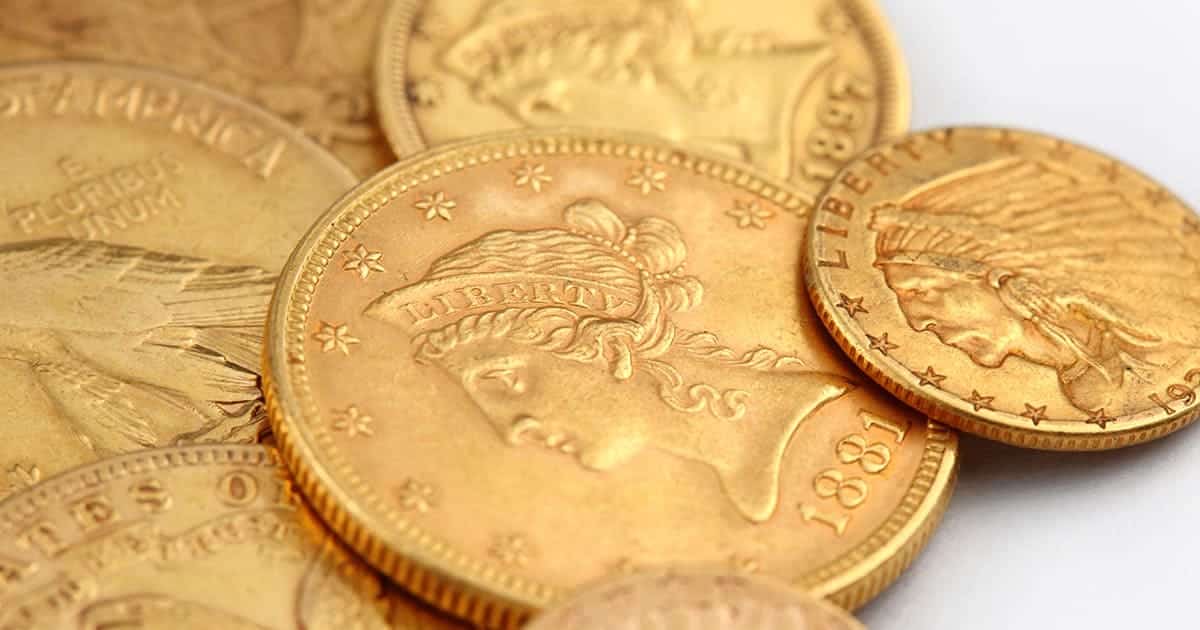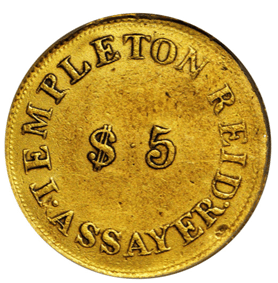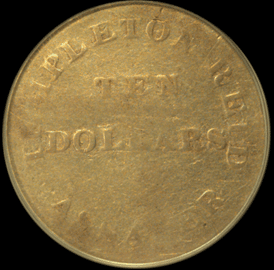
Learn About Georgia Gold and Templeton Reid
GOLD! Gold was discovered in Georgia in the 1820s as well as in North Carolina. While it wasn’t of the magnitude of the strike in California nearly 25 years later, it was significant enough to gain the US Government’s attention and to authorize minting facilities to be built in both Charlotte, North Carolina and in Dahlonega, Georgia. But those Mints would not open until 1838. Prior to their beginning operations, private minters stepped up to fill the void that existed. Otherwise, Gold ore and Gold Dust would need to be sent by wagon up to Philadelphia – a 1,500-mile roundtrip!
A Milledgeville, GA, jeweler and gunsmith stepped into the breach and struck the very first private gold coinage in the United States. Templeton Reid saw the opportunity and decided to try his hand at striking coins from Georgia-mined gold. To be closer to the source, Reid moved his operations to Gainesville in July of 1830. He set up a rudimentary, but efficient, minting facility and designed three different denominations of private gold coins. To gain acceptance he mimicked the United States Mint and designed and struck coins in $2.50, $5.00 and $10.00 denominations. Early newspaper accounts state that his finished product rivaled that of the national mint but given the simplicity of his designs, local pride was affecting common sense. The typical US Mint Gold Coin of the era was far superior to that produced by Mr. Reid.

Reid began striking coins in July 1830 and struck specimens until October of that same year. He encountered great opposition to what he was doing – but not because his weights were not accurate. They were as accurate as could be done. But his assays were suspect, meaning the purity of the gold was not as claimed. It is believed that Reid struck his coins from the native gold dust and ore as they came from the ground. He did not assay it to a standard fineness, as would be expected, and consequently, instead of being .999 Fine, it averaged .9375 Fine. This meant that the coins did not contain the actual amount required at the time.
So Reid’s $10.00 Gold Eagles, did not contain $10.00 worth of pure gold. Rather they contained $9.38 worth of pure gold. His $5.00 and $2.50 gold coins were similarly “short.” It is believed that this was not intentional, rather it was an oversight. Gold, as it comes from the ground, is always alloyed with other metals to provide durability and increase purity. Generally, silver, copper, or tin, alone or in combination with other metals are used as the alloy. In order to determine the precise specifications of native gold, a sophisticated assay means is required. In the 1830s, this was generally done in a laboratory and Reid had no such laboratory or the ability to conduct this assay. It is believed that Reid was adamant about the purity of his native gold.
But once this fact was reported to the press and reported locally, the public then distrusted Reid and his coinage, which previously had been accepted on a par with the national gold coins, no longer was wanted and ceased to be an important local medium of exchange.
Reid was excoriated in the press by an unnamed person who had some of Reid’s gold assayed at his own expense. They debated the points back and forth in the press, but the damage was done. Reid’s product was believed to be inferior and he never regained the trust of local bankers and merchants. His media opponent, however, was never challenged and simply printed his rebuttals as written. Reid was unable to battle an unnamed opponent who enlisted the aid of crusading newspaper publishers.
His coinage is represented here, as the earliest of all private gold coinage. The Quarter Eagle ($2.50) coin’s obverse had the date “1830” as the central vignette with the words “GEORGIA” and “GOLD” around the periphery.
The reverse of these coins had the denomination in the center “2.50” with “T. Reid” above and “ASSAYER” below.

He struck about 1,000 Quarter Eagles, which accounts for the vast majority of coins that survive to this day. Many of his coins were melted after the controversy had ruined his reputation as a coin assayer and minter.


(The Templeton Reid $5.00 Half Eagle gold coin. Obverse [left], Reverse [right].)
The design of his $5.00 Half Eagle varied slightly from that of his Quarter Eagle. The obverse featured the denomination in the center “$ 5” with “GEORGIA GOLD” around the upper periphery and the date “1830” at the bottom of the obverse.
The reverse was again unimaginative. The denomination “$ 5” was also the central vignette on the reverse. Around the periphery were the words “TEMPLETON REID ASSAYER”.
A bit more than 300 of these coins were struck but only 7 examples are known to still exist today.


(The RARE and Elusive Templeton Reid Gold Eagle)
The Gold Eagle also had about 300 coins originally struck and there are two reverse designs. The coin pictured is one of the two designs known. The obverse has the date “1830” in the central portion with “GEORGIS GOLD” above and below the denomination around the periphery.
The reverse has the denomination spelled out in two lines at the center “TEN DOLLARS” with “TEMPLETON REID” above and “ASSAYER” below. There are only 6 of these specimens known.
There is an even scarcer version that omits the date from the central portion of the obverse, of which, there are only 3 knowns.
There was no collector interest at the time, especially after the perceived scandal, so most of these coins were subsequently melted.
| Date | Type | Mintage | VF Value | EF Value |
| 1830 | Quarter Eagle | 1,000 Struck; 35-50 Known | $165,000 | $250,000 |
| 1830 | Half Eagle | 300 Struck; 7 Known | $450,000 | $625,000 |
| 1830 | Eagle | 300 Struck; 6 Known | $750,000 | $1,000,000 |
| (1830) | Eagle; Dateless | Included Above; 3 Known | Priceless | Priceless |
Expand your collection today and shop our assortment of pre-1933 U.S. Gold Coins.





